Os melhores subwoofers domésticos trazem aquele trovão de baixa frequência dinâmico e vibrante que estabelece uma base sólida para uma experiência de audição musical imersiva.
Muitas pessoas costumam explodir alto-falantes no volume máximo, mas seu sub não consegue produzir graves adequados ou as frequências altas sobrecarregam as frequências baixas.
Observe que, se você estiver enfrentando problemas de volume baixo do subwoofer, temos um guia sobre como corrigir problemas de volume baixo do subwoofer.
Então, como você obtém mais graves do seu subwoofer doméstico? Neste artigo, discutiremos várias maneiras de fazer exatamente isso!
1. Posicionamento do subwoofer
Encontrar o local certo para o seu subwoofer doméstico é o primeiro passo para garantir que você obtenha a quantidade desejada de graves do dispositivo.
Leve em consideração como o sub funciona com os outros alto-falantes e como você pode aproveitar ao máximo sua sala pequena ou grande.
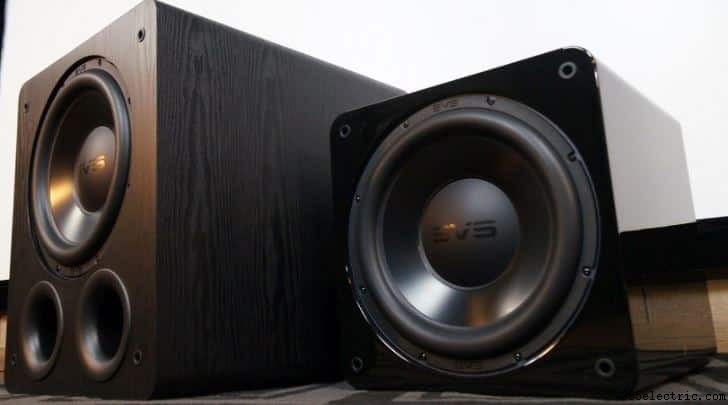
Configurar seu home sub em um canto pode aumentar o volume, mas você precisa ter cuidado para evitar a possibilidade de seus ouvintes acharem a saída muito barulhenta.
Movê-lo para perto dos alto-falantes pode ajudá-lo a misturar as frequências mais baixas e mais altas. Mas em alguns casos, isso também pode causar ressonância indesejada.
Para obter mais graves e perfeitos, você pode experimentar o posicionamento. Ao experimentar, tente o máximo possível:
- Posicione o subwoofer longe da parede e entre os dois alto-falantes principais
- Coloque-o em uma parede lateral, a meio caminho entre as paredes traseiras e as paredes frontais.
Além disso, a colocação do subwoofer quando você tem um sofá na sala também é importante. Em particular, existem considerações especiais para o posicionamento do subwoofer quando o sofá está encostado na parede. Outra ótima opção é colocar o subwoofer atrás do sofá. Por outro lado, muitas vezes não é uma boa ideia colocar o subwoofer embaixo do sofá ou colocar o subwoofer atrás da TV.
Se nenhuma dessas técnicas o ajudar a obter mais graves, comece a mover o subwoofer. Faça isso lentamente enquanto ouve as variações na produção do baixo.
2. Ajuste as configurações do seu subwoofer
Depois de encontrar o local ideal para o seu subwoofer, ajuste-o ainda mais até começar a obter o melhor som. Aqui está o procedimento simples que você pode seguir para configurá-lo adequadamente.
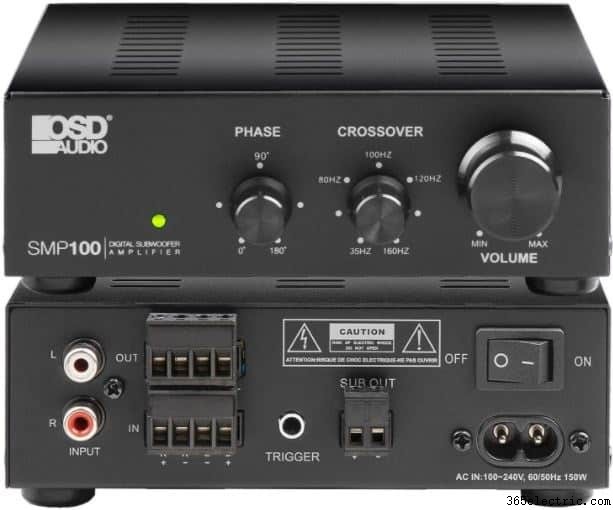 Etapa 1:ajuste o cruzamento:
Etapa 1:ajuste o cruzamento: Ajustar o crossover antes de tocar o subwoofer é a melhor solução. Defina-o na faixa de 4 Hz a 60 HZ se você tiver alto-falantes grandes de chão.
Aumente o alcance para entre 50 Hz e 80 Hz se você estiver usando alto-falantes principais de estante menores. Para pequenos alto-falantes satélites, você deve ajustar o crossover na faixa de 80HZ a 160Hz.
Etapa 2:defina o volume do subwoofer para o nível desejado: Depois de definir o crossover, ligue a energia. E então ajuste o volume até que os subwoofers comecem a produzir graves mais precisos.
Etapa 3:ajuste o controle de fase: Um controle de fase bem ajustado ajuda a compensar os atrasos entre os alto-falantes principais e o subwoofer doméstico.
Se o controle estiver disponível, certifique-se de ajustá-lo conforme apropriado. Comece com o 0 ou posição normal. Se isso permitir que você obtenha graves adequados de sua posição de audição, você atingiu seu objetivo.
Mas se você perceber que o som ainda está fraco, continue ajustando o controle de fase até obter o tipo de baixo desejado.
Etapa 4:ajuste as frequências: Definir o equalizador de áudio estéreo também pode ajudá-lo a obter mais graves se permanecer fino.
Assim como com a comida, tanto audiófilos dedicados quanto ouvintes casuais podem ter certas preferências de som únicas. A boa notícia é que o controle do equalizador permite que você ajuste os áudios para atender às suas necessidades de som exclusivas em poucos minutos.
3. Use novos conectores e cabos
Tal como acontece com tudo neste belo planeta, os conectores e cabos do subwoofer se degradam com o tempo. Sem dúvida, isso pode afetar diretamente a qualidade dos graves que seu subwoofer doméstico oferece.
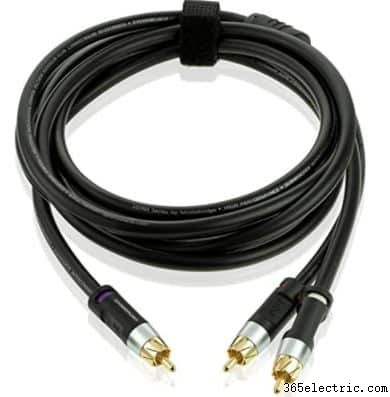
Ao mesmo tempo, fios minúsculos e baratos geralmente reduzem o fluxo de corrente elétrica. Isso também pode privar seu sub da quantidade de energia necessária para produzir graves de qualidade.
Como regra, você deve inspecionar os cabos do subwoofer regularmente e substituí-los sempre que necessário.
Sem surpresa, muitas pessoas observam essa recomendação e usam cabos de qualidade. Mas eles emendam os fios de forma errada e acabam com graves imerecidos sem saber a causa do problema.
Outros também ignoram a essência da compra de conectores de cabo de qualidade. Sem os conectores corretos, seus cabos de qualidade não poderão ajudá-lo a obter mais graves do seu subwoofer.
4. Escolha um gabinete portado
A escolha de subwoofers com portas traseiras ou frontais pode desempenhar um papel importante no aumento dos graves que você obtém. A porta reforça as baixas frequências de graves mais do que os gabinetes selados.
No entanto, esse design oferece a melhor qualidade de som se a caixa for um pouco mais espaçosa.
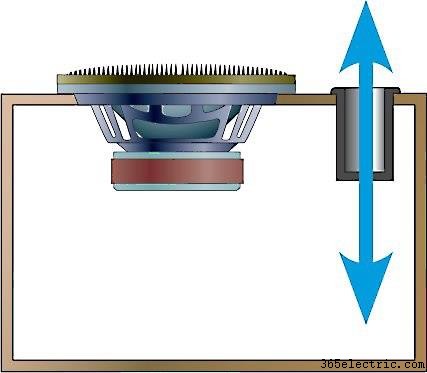
O espaço extra permite que o cone do submarino tenha liberdade de movimento adequada. As aberturas também podem redirecionar o som da parte traseira do cone e adicioná-lo ao que emana da frente do sub, tornando os graves muito mais altos.
Os recursos acima dos subwoofers domésticos com portas os tornam incrivelmente eficientes. Com o aumento da eficiência vem a redução da energia necessária para produzir mais graves de forma consistente.
Se você acha que o design da caixa é o problema, saiba mais sobre o design da caixa de alto-falante para graves profundos.
5. Encha a caixa com enchimento de fibra de poliéster
Preencher seu gabinete portado com enchimento de fibra de poliéster, como polyfill, também pode aumentar a qualidade do baixo que você obtém do seu submarino doméstico.
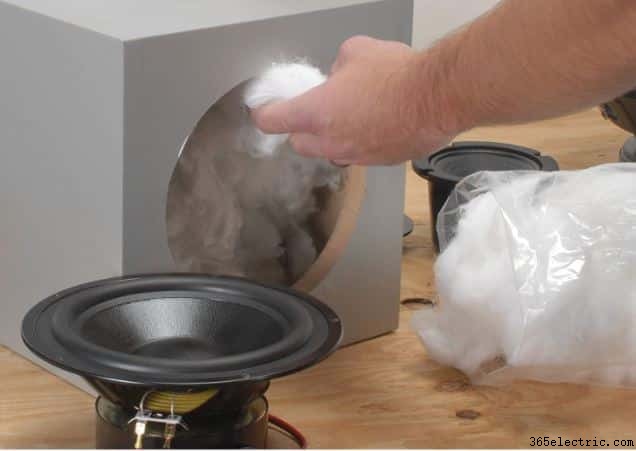
Como dissemos, um subwoofer com porta funciona melhor em uma caixa grande. Se o seu gabinete for pequeno, você pode fazer o submarino pensar que é grande o suficiente, preenchendo-o com este material.
Eu sei que você pode estar dizendo que essa dica parece contra-intuitiva. Possivelmente, você também está perguntando o que encher a caixa com enchimento de fibra de poliéster tem a ver com o baixo do seu submarino doméstico.
Bem, o fato da vida é que o enchimento diminui as ondas sonoras dentro dos subwoofers. Quando isso acontece, o sub se engana que a caixa é grande e melhora a quantidade e a qualidade dos graves que ela produz.
For the best bass quality, however, you should use between one and one-and-a-half pounds of polyester fiber per cubic foot of your ported subwoofer’s volume.
6. Minimize Electrical Impedance
Electrical impedance refers to the resistance that subwoofers face in converting electrical signals into audio.
A high level of resistance may reduce the device’s ability to produce quality bass.
To mitigate this problem, you should match the specifications of your subs and audio system. Moreover, you need to ensure that the coils and magnets are in the best working condition.
7. Use Quality Audio Files
The quality of the music files that you play can also affect the bass that your subwoofer emits.
If your files have been over-compressed, they have low quality and will likely not produce the bass you yearn for.

The compression always leads to the loss of low-frequency details that your subwoofer requires to deliver the kind of listening experience that best serves you.
If you like streaming online content, you also better watch out for the option that allows you to set the appropriate bass and the overall sound quality.
Alternatively, you can stick to the streaming services that provide higher resolution and get more bass out of your home subwoofer whenever you want.
Two of the best audio files for high-quality bass output are FLAC and AIFF. You can also use lossless MP4 or any other lossless audio files.
8. Run Multiple Subs
There is another never-ending question that we should address here. Some people want to know whether two subwoofers guarantee better bass than one.
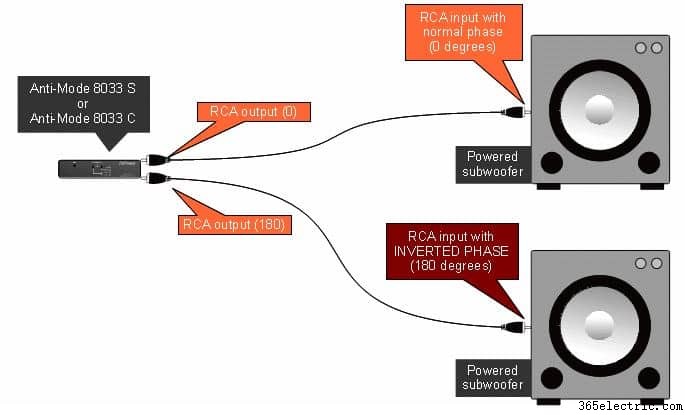
The answer is ‘yes.’ But for you to realize your goal, it is recommended that the subs should be of the same model and brand.
Due to the subs’ combined bass output, they will yield a much better base if you above these conditions and supply adequate power.
9. Feed Subs Enough Electric Power
Assuming you have done everything required to minimize electrical impedance, you cannot have an impressive listening experience if you are using an unreliable source of power.
You need to have enough power given that bass notes need more electric energy than higher-level frequencies.
If you underpower your home theater system under any circumstances, you will not get proper bass.
In this case, your sub will turn up a distorting signal in an attempt to get bass volume. In fact, your under-powered subwoofer will likely get damaged.
10. Add Sound Deadening Material
Adding sound-deadening materials, also known as damping, helps to get rid of vibrations and noise. These interruptive forces compete with music and distort your listening experience.
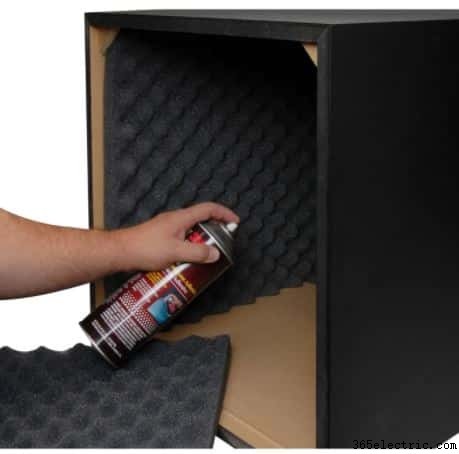
Minimize the risk by lining up the walls with a layer of acoustic foam or any other sound deadening material.
The materials will absorb sound reflections and cut the standing waves. If you can remember, we said that you could use material like polyfill to improve bass by making the box seem ‘larger’ as the waves move through.
However, in this case, we are damping to deal with the reflections, which are another major enemy of quality bass.
11. Invest In An Amplifier
Firstly, if you cannot afford an amplifier, that is fine. There are many ways to improve bass output without an amplifier.
However, if you crave more bass out of your subwoofer and your budget allows you to invest in a high-quality amplifier, you can make your subwoofer blast louder with one of the best amps out there.
But it does not end at buying an expensive amplifier. You must be able to set it up appropriately. Follow this simple process to do so.
You need to choose the best amp rack based on the material used to make it. The acoustic properties of the material the amp is placed on will have a direct impact on amps’ efficiency, and that can reduce its ability to amplify the sound that your home subwoofer produces.
For example, if you go for glass shelves, your sub is likely to sound forward. But your wooden support is highly expected to bring about a louder, more rounded, and warmer balance.
Moreover, you should think about the spacing between the wall and the amp. A few inches of breathing space can ensure that the amp maintains the right temperature, determining the level of efficiency.
Bi-amping allows you to use at least two power amplifiers. This allows each amplifier to handle various channels or frequencies.
By doing this, you reduce the workload of your amp. In turn, it operates efficiently and helps the subwoofer to produce better-quality bass.
Proper amplifier connections will also determine whether the amp will help your home subwoofer to produce louder bass.
Before placing the back to the wall, take your time to check the amplifier’s rear panel to find the available options for connecting different sources. Connect via the RCA or LFE inputs.
The same way you can upgrade your subwoofer, your amp may require upgrading too. Upgrading does not necessarily mean doing away with the old amplifier.
One way you can handle this is by using an amp with pre-amp outputs solely as a pre-amp. You then pass on the other duties onto another amplifier. At the same time, you can choose to upgrade your amp’s mains cable.
12. Add a Subwoofer Horn
A subwoofer horn can increase the efficiency of your sub. The simplest way to identify it is to look for a flared tube and attach it to the sub’s output.
The horn will serve to direct the sound to the right listening location, increasing your chances of getting a quality base despite the relatively long distance between you and the subs. The increased efficiency will also help you to achieve better power output and power transfer.
However, you should avoid the possibility of the air’s non-linear nature from causing the horns to distort the audio.
This often occurs when much power is put through. Also, too much wind noises can come through the horns and cause distortions as the air pushes against the horn’s surface. You need to test this technique, whether it works for you before you make the decision.
13. Replace the Subwoofer
I believe we all agree that subs are not created equal. Some were not designed with the need of the end-user in mind. There are instances when the best way to increase the bass output is to invest in a quality subwoofer.
In some instances, you can modify your sub significantly to be able to improve its performance. If you are in such a scenario and do not want to dirty your hands by trying to modify it, the only viable option could be to replace it.
Remember that when it comes to subwoofers, size also matters. That means if you are a having a 6.5 inches sub and are serious about getting the type of bass that guarantees you a kind of bone-shaking impact, you have no choice. No technique can give the experience if you do not replace the small for a bigger subwoofer.
Let’s take an example, if you compare 10″ vs 12″ subwoofers, you will find that 12″ subs will deliver more bass. That is not to imply that small subwoofers cannot offer you impressive performance. The truth is that this boils down to your preference. If you are okay with smaller subs, you can still use the other tips in this guide to boost your listening experience.
How Do I Make Subwoofer Louder Without Amplifier?
Amplifiers are expensive, and it’s wise to take steps to make your subs louder before deciding to obtain an amplifier.
Step 1: Place your sub in a corner, as this can provide up to six decibels of bass boost without amplification.
Step 2: Make sure the subwoofer is in phase with the rest of the system without any variance. Play some bass-heavy music and adjust the phase switch until you hear the loudest bass.
Step 3: Place the subwoofer in an asymmetrical position relative to room boundaries will result in louder bass output and the smoothest overall response.
Etapa 4: Fine-tune the subwoofer crossover controls to get louder bass than just randomly setting it or leaving it at the default factory settings.
Final Thoughts
Whether you are on a tight budget or not but crave more bass out of your subwoofer, we are confident that this guide has your needs covered. Most of these methods are affordable and straightforward.







